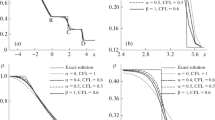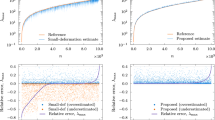Abstract
A new Godunov-type scheme for a complete nonlinear system of equations is developed as applied to the simulation of flows in an elastic deformable pipe. The proposed finite-difference method makes use of a one-dimensional grid, but the grid cells are characterized by two spatial sizes. The multidimensional effects and, primarily, pipe deformations are taken into account in the course of grid cell reconstruction. Difference relations are written for such a reconstructed grid. Due to the grid reconstruction procedure, the elastic deformation of the pipe can be taken into account directly without introducing the velocity of propagation of perturbations in the system “weakly compressible fluid–cylindrical shell.” The algorithm was shown to be highly accurate as applied to the water hammer problem.





Similar content being viewed by others
REFERENCES
N. E. Zhukovskii, Water Hammer in Pipelines (Gostekhteorizdat, Moscow, 1949) [in Russian].
L. Allievi, Theoria generale del modo perturbato dell’ acdua nei tubi in pressione (Milan, 1903).
O. Schnyder, “Druckstosse in Pumpensteigletungen,” Schweiz Bauztg. 94, 22–23 (1929).
L. Bergeron, “Etudes des variations de regime dans les conduits d’eau,” Rev. Gen. Hydraulique, Nos. 1–2 (1935).
C. A. M. Gray, “The analysis of the dissipation of energy in water hammer,” Proc. ASCE 119 (274), 1176–1194 (1953).
C. A. M. Gray, “Analysis of water hammer by characteristics,” Trans. Am. Soc. Civil Eng. 119, 1176–1189 (1954).
V. L. Streeter and C. Lai, “Water hammer analysis including fluid friction,” J. Hyd. Div. ASCE 88 (3), 79–112 (1962).
E. B. Wylie and V. L. Streeter, Fluid Transients (McGraw-Hill, New York, 1977).
M. V. Lur’e, Mathematical Simulation of Pipeline Transport of Oil, Oil Products, and Gas (Ross. Gos. Univ. Nefti i Gaza im. I.M. Gubkina, Moscow, 2012) [in Russian].
D. A. Foks, Hydraulic Analysis of Transient Flows in Gas Pipelines (Energoizdat, Moscow, 1981) [in Russian].
V. L. Streeter, “Unsteady flow calculation by a numerical method,” J. Basic Eng. 94, 457–466 (1972).
M. H. Chaudhry and M. Y. Hussaini, “Second-order accurate explicit finite difference schemes for water hammer analysis,” J. Fluid. Eng. 107, 523–529 (1985).
G. K. Nathan, J. K. Tan, and K. C. Ng, “Two-dimensional analysis of pressure transients in pipelines,” Int. J. Numer. Methods Fluids 8 (3), 339–349 (1988).
J. L. Bribiesca, “A finite-difference method to evaluate water hammer phenomenon,” J. Hydrol 51, 305–311 (1981).
J. K. Tan, K. C. Ng, and G. K. Nathan, “Application of the center implicit method for investigation of pressure transients in pipelines,” Int. J. Numer. Methods Fluids 7, 395–406 (1987).
M. Arfaie and A. anderson, “Implicit finite-differences for unsteady pipe flow,” Math. Eng. Ind. 3, 133–151 (1991).
K. C. Ng and C. Yap, “An investigation of pressure transients in pipelines with two-phase bubbly flow,” Int. J. Numer. Methods Fluids 9, 1207–1219 (1989).
V. E. Seleznev, V. V. Aleshin, and G. S. Klishin, Methods and Technologies for Modeling Gas Pipeline Systems (Editorial URSS, Moscow, 2002) [in Russian].
V. Guinot, “Boundary condition treatment in 2 × 2 systems of propagation equations,” Int. J. Numer. Meth. Eng. 42, 647–666 (1998).
E. B. Wylie and V. L. Streeter, “Network system transient calculations by implicit method,” The 45th Annual Meeting of the Society of Petroleum Engineers of AIME, Paper no. 2963 (1970).
A. Verwey and J. H. Yu, “A space-compact high-order implicit scheme for water hammer simulations,” Proceedings of 25th IAHR Congress (Tokyo, Japan, 1993), Vol. 5, pp. 363–370.
A. Verwey and S. Illic, “A space-compact high-order implicit scheme for 1-d advection simulations,” Proceedings of 25th IAHR Congress (Japan, Tokyo, 1993), Vol. 5.
C. Hirsch, Numerical Computation of Internal and External Flows (Wiley, New York, 1990).
E. F. Toro, Riemann Solvers and Numerical Methods for Fluid Dynamics (Springer-Verlag, Berlin, 1997).
V. Joviґc, “Finite elements and the method of characteristics applied to water hammer modeling,” Eng. Model. 8, 51–58 (1995).
J. J. Shu, “A finite element model and electronic analogue of pipeline pressure transients with frequency-dependent friction,” J. Fluid. Eng. 125, 194–199 (2003).
C. Bisgarrd, H. H. Sorensen, and S. Spangenberg, “A finite element method for transient compressible flow in pipelines,” Int. J. Numer. Methods Fluids 7, 291–303 (1987).
Y. G. Cheng, S. H. Zhang, and J. Z. Chen, “Water hammer simulation by the lattice Boltzmann method,” Trans. Chinese Hydraulic Eng. Society, J. Hydraulic Eng. 6, 25–31 (1998).
Y. G. Cheng and S. H. Zhang, “Numerical simulation of 2-D hydraulic transients using lattice Boltzmann method,” Transactions of the Chinese Hydraulic Eng. Society, J. Hydraulic Eng. 10, 32–37 (2001).
Q. Hou, A. C. H. Kruisbrink, A. S. Tijsseling, and A. Keramat, “Simulating water hammer with corrective smoothed particle method,” CASA-Report, Vol. 1214 (Eindhoven University of Technology, Department of Math. and Comput. Sci., Eindhoven, 2012).
Q. Hou, A. C. H. Kruisbrink, A. S. Tijsseling, and A. Keramat, “Simulating transient pipe flow with corrective smoothed particle method,” The 11th International Conference on Pressure Surges (BHR Group, Lisbon, 2012), pp. 171–188.
S. A. Gubin, A. V. Evlampiev, and S. I. Sumskoi, “Computation of transient processes in oil pipelines in standard operational conditions and emergency breakage,” Collected Papers of MIFI-99 Scientific Session, Vol. 1: Ecology and Rational Nature Management, Biophysics, Medicine Physics and Technology, Mathematical Methods in Scientific Research, and Theoretical Problems in Physics (Mosk. Inzh.-Fiz. Inst., Moscow, 1999), pp. 33–35.
V. Guinot, “Riemann solvers for water hammer simulations by Godunov method,” Int. J. Numer. Meth. Eng. 49, 851–870 (2000).
V. Guinot, “Numerical simulation of two-phase flow in pipes using Godunov method,” Int. J. Numer. Meth. Eng. 50, 1169–1189 (2001).
Y. Hwang and N. Chung, “A fast Godunov method for the water-hammer problem,” Int. J. Numer. Methods Fluids 40 (6), 799–819 (2002).
M. Zhao and M. S. Ghidaoui, “Godunov-type solution for water hammer flows,” J. Hydraulic Eng. 130 (4), 341–348 (2004).
S. R. Sabbagh-Yazdi, N. E. Mastorakis, and A. Abbasi, “Water hammer modeling by Godunov type finite volume method,” Int. J. Math. Comput. Simul. 1 (4), 350–355 (2007).
S. Bousso and M. Fuamba, “Numerical simulation of unsteady friction in transient two-phase flow with Godunov method,” J. Water Resource Protect. 5, 1048–1058 (2013).
S.-R. Sabbagh-Yazdi, A. Abbasi, and N. E. Mastorakis, “Water hammer modeling using 2nd order Godunov finite volume method,” Proc. Eur. Comput. Conf., Lect. Notes Electrical Eng. 28, 215–223 (2009).
F. Kerger, P. Archambeau, S. Erpicum, B. J. Dewals, and M. Pirotton, “An exact Riemann solver and a Godunov scheme for simulating highly transient mixed flows,” J. Comput. Appl. Math. 235, 2030–2040 (2011).
S. I. Sumskoi, A. M. Sverchkov, M. V. Lisanov, and A. F. Egorov, “Simulation of systems for shock wave/compression waves damping in technological plants,” J. Phys. Conf. Ser. 751 (1), 012023 (2016).
S. I. Sumskoi and A. M. Sverchkov, “Modeling of nonequilibrium processes in oil trunk pipeline using Godunov type method,” Phys. Proc. 72, 347–350 (2015).
S. I. Sumskoi, A. M. Sverchkov, M. V. Lisanov, and A. F. Egorov, “Simulation of compression waves/shock waves propagation in the branched pipeline systems with multi-valve operations,” J. Phys. Conf. Ser. 751 (1), 012024 (2016).
S. I. Sumskoi, A. M. Sverchkov, M. V. Lisanov, and A. F. Egorov, “Modeling of nonequilibrium flow in the branched pipeline systems,” J. Phys. Conf. Ser. 751 (1), 012022 (2016).
S. K. Godunov, “A difference method for numerical calculation of discontinuous solutions of the equations of hydrodynamics,” Mat. Sb. 47, 271–306 (1959).
A. G. Kulikovskii, N. V. Pogorelov, and A. Yu. Semenov, Mathematical Aspects of Numerical Solution of Hyperbolic Systems (Fizmatlit, Moscow, 2001; Chapman and Hall/CRC, London, 2001).
C. Bourdarias and S. Gerbi, “A conservative model for unsteady flows in deformable closed pipes and its implicit second-order finite volume discretization,” Comput. Fluids 37 (10), 1225–1237 (2008).
A. T. Il’ichev and V. A. Shargatov, “Modeling unsteady flows in elastic pipes: Energy conservation law,” in Problems of Mathematical Physics and Mathematical Modeling: Book of Abstracts of the 6th International Conference (National Research Nuclear University MEPhI, Moscow, 2017), pp. 46–47.
ACKNOWLEDGMENTS
This work was supported by the Russian Science Foundation, grant no. 16-19-00188.
Author information
Authors and Affiliations
Corresponding author
Additional information
Translated by I. Ruzanova
Rights and permissions
About this article
Cite this article
Sumskoi, S.I. New Godunov-Type Method for Simulation of Weakly Compressible Pipeline Flows with Allowance for Elastic Deformation of the Walls. Comput. Math. and Math. Phys. 58, 1647–1659 (2018). https://doi.org/10.1134/S096554251810010X
Received:
Revised:
Published:
Issue Date:
DOI: https://doi.org/10.1134/S096554251810010X




